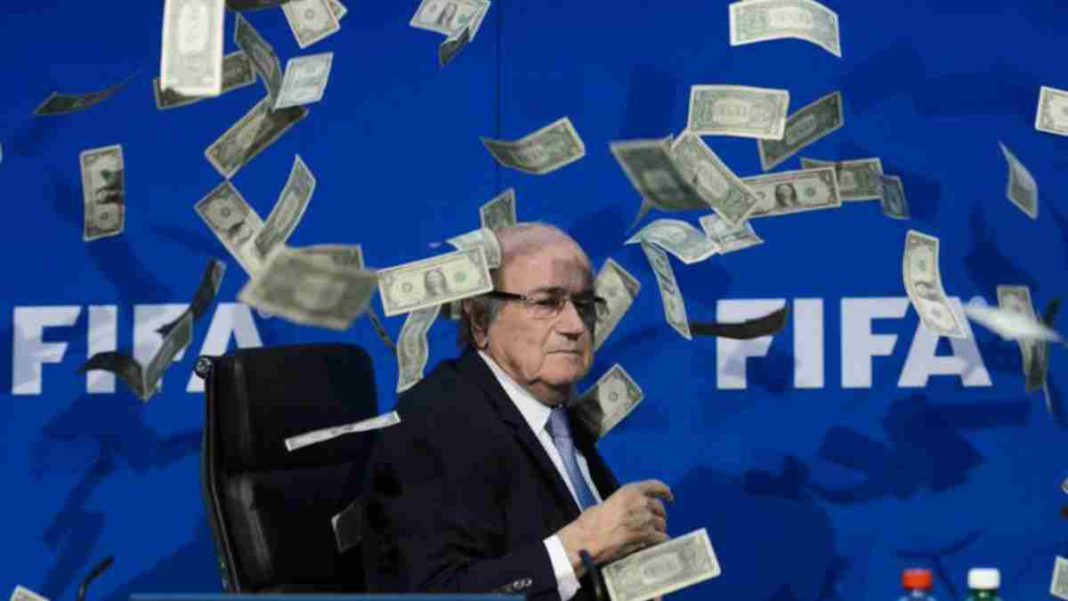INDIA: The global football community was shocked when many senior members of FIFA, the World Governing Body for Football, were arrested. The arrests occurred in Zurich, Switzerland, on May 27, 2015.
The FBI indicted the members with multiple charges of racketeering, wire fraud, money laundering, and other felonies spanning over two decades. The incident sparked a major controversy regarding FIFA, headed by Sepp Blatter.
History of FIFA
Seven European football associations formed FIFA in 1904. It was an amateur organization until 1974, when major political movements for power ensued inside the organization, which became a turning point in its tryst with corruption.
Sir Stanley Rous, an ex-English football administrator, was the President of FIFA at that time. He was notorious for having a tolerant view regarding the Apartheid regime in South Africa.
João Havelange, a Brazilian businessman, was a candidate for the FIFA presidency. He promised money and the development of football in Africa. His promises swooned the African football associations, and he won the election.
Despite the promises, FIFA could not support African football due to financial limitations. João Havelange called upon Sepp Blatter to help the organization increase its financial capabilities.
Blatter convinced Coca-Cola, one of the most famous soft drink companies, to sponsor FIFA events. FIFA became the first sporting organization to introduce sponsors for development purposes.
The FIFA-Coca Cola Program laid the foundation for modern-day FIFA. Once the partnership between FIFA and Coca-Cola benefitted both parties, more companies began proposing sponsorship deals with FIFA.
The German sporting equipment company Adidas signed a deal with FIFA to supply equipment for its events. KLM, Phillips, Canon, Gillette, and a Brazilian firm, Cafes Do Brasil, penned contracts with FIFA. Multiple companies began to attach themselves to football at a global level.
1978 FIFA World Cup in Argentina
In 1978, FIFA raked in massive money through sponsorship deals and partnerships. However, the 1978 FIFA World Cup held in Argentina was a turning point for FIFA, both financially and politically.


On March 24, 1976, a coup led by the military overthrew Isabel Peron as president of Argentina. The military administrative council, also known as the “Military Junta,” was installed to replace her. Lt. General Jorge Rafael Videla headed the council.
The military government persecuted the minority systematically, a genocidal process.
Despite the crimes against humanity committed by the Argentinian government, the FIFA World Cup went ahead. FIFA faced heavy criticism for its decision to proceed with the World Cup. It drew comparisons to the 1936 “Hitler Olympics” in Berlin. There were several calls for nations and players to boycott the World Cup. Despite the criticism, the event went smoothly, and Argentina won the World Cup.
It seemed that sport was following a disturbing trend of being “bought” by nations despite being crippled with human rights issues rather than using its power and voice to take an opposing stance against global human rights issues. Notable examples of this are the 1936 Olympics in Germany and the 1978 FIFA World Cup.
Roots of corruption inside FIFA
The 1978 World Cup kicked off the speculations of João Havelange being corrupt despite his historic figure within the organization. He was known to have maintained a close relationship with Horst Dassler, the owner of Adidas.
For the 1982 FIFA World Cup in Spain, Adidas did the overall marketing for FIFA. Horst Dassler tactically handed a payout to João Havelange through a shady contract to ensure he got the rights to market the event. This payout by Dassler was effectively a bribe.
With the advent of televisions and their rapid development, broadcasting FIFA World Cup matches guaranteed money-making prospects. Dassler bought the rights to the World Cup from FIFA and sold it to different broadcasting companies.
João Havelange was aware of the dealing of rights by Dassler but turned a blind eye towards the actual market value of the FIFA World Cup. As per speculation, he did so because of his financial gains from Horst Dassler. Horst Dassler formed ISL, the International Sports & Leisure Company, and turned his attention to the broadcast of FIFA matches. He bought almost all the TV rights from FIFA.
In 1981, Sepp Blatter, who had been on the sidelines of the FIFA administrative council, became the Secretary-General. He was effectively the second in the power of FIFA, next only to João Havelange. FIFA was making a lot of money, and Havelange was virtually untouchable within FIFA.
After an unknown period, Sepp Blatter found proof of corruption by João Havelange. He discovered receipts of $1.5 million accidentally sent by ISL to FIFA instead of Havelange. Blatter made a deal with Havelange that he would relinquish his presidency after four years and put Blatter in charge of FIFA as his successor. The agreement ensured that Havelange could leave with his reputation intact, with Blatter finally getting the reigns of the most prominent sporting organization in the world.
Also Read: FIFA World Cup: Morocco Creates History by Stunning Portugal 1-0 in Quarterfinals



